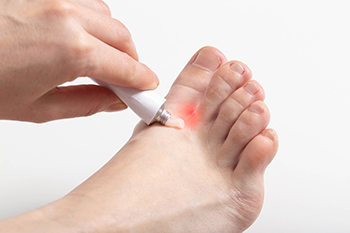
Athlete's foot is a common and highly contagious fungal infection caused by an overgrowth of the tinea fungus. While not typically serious, it can be uncomfortable and annoying. This fungus thrives in warm, moist, and airless environments, making it more likely to spread in places like public changing rooms and showers. Symptoms of athlete's foot include an itchy and scaly rash, blisters, cracked skin, and in some cases, changes to the toenails. To prevent this condition, wear shoes that fit well and are breathable, change them regularly, and avoid sharing towels. For self-care, use topical antifungal treatments like sprays, liquids, or powders and follow the instructions carefully. Continue treatment even after symptoms disappear to eradicate the fungus completely. If these treatments fail or the infection becomes severe, it is wise to consult a podiatrist. This is especially important if you experience pain, redness, or have underlying conditions, such as diabetes or a weakened immune system. For help with problems caused by athlete’s foot, it is suggested that you make an appointment with a podiatrist.
Athlete’s foot is an inconvenient condition that can be easily reduced with the proper treatment. If you have any concerns about your feet and ankles, contact one of our podiatrists from Cleveland Foot & Ankle Clinic. Our doctors will treat your foot and ankle needs.
Athlete’s Foot: The Sole Story
Athlete's foot, also known as tinea pedis, can be an extremely contagious foot infection. It is commonly contracted in public changing areas and bathrooms, dormitory style living quarters, around locker rooms and public swimming pools, or anywhere your feet often come into contact with other people.
Solutions to Combat Athlete’s Foot
- Hydrate your feet by using lotion
- Exfoliate
- Buff off nails
- Use of anti-fungal products
- Examine your feet and visit your doctor if any suspicious blisters or cuts develop
Athlete’s foot can cause many irritating symptoms such as dry and flaking skin, itching, and redness. Some more severe symptoms can include bleeding and cracked skin, intense itching and burning, and even pain when walking. In the worst cases, Athlete’s foot can cause blistering as well. Speak to your podiatrist for a better understanding of the different causes of Athlete’s foot, as well as help in determining which treatment options are best for you.
If you have any questions please feel free to contact our offices located in Cleveland, Independence, and Kent, OH . We offer the newest diagnostic and treatment technologies for all your foot and ankle needs.
